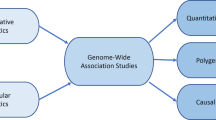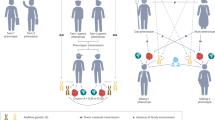Abstract
The contributions of Lindon Eaves to the development of the subject of behavior genetics are reviewed, with a focus on the 1970s, the first astonishing decade of his career when he made major theoretical advances in the design and power of human quantitative genetic studies, including treatment of assortative mating, cultural transmission, sex limitation, sibling effects, gene-environment interaction and covariation, and multivariate genetic analysis. He also made important substantive contributions to our understanding of the causes of individual differences in cognition, personality, social and sexual attitudes, and smoking.
Similar content being viewed by others
References
Boomsma DI, Vink JM, van Beijsterveldt TC, de Geus EJ, Beem AL, Mulder EJ, Derks EM, Riese H, Willemsen GA, Bartels M, van den Berg M, Kupper NH, Polderman TJ, Posthuma D, Rietveld MJ, Stubbe JH, Knol LI, Stroet T, van Baal GC (2002) Netherlands twin register: a focus on longitudinal research. Twin Res 5:401–406
Eaves LJ (1969) The genetic analysis of continuous variation: a comparison of experimental designs applicable to human data. Br J Math Stat Psychol 22(2):131–147
Eaves LJ (1970) The genetic analysis of continuous variation: a comparison of experimental designs applicable to human data—11 Estimation of heritability and comparison of environmental components. Br J Math Stat Psychol 23(2):189–198
Eaves LJ (1972a) Computer simulation of sample size and experimental design in human psychogenetics. Psychol Bull 77(2):144–152
Eaves LJ (1972b) The multivariate analysis of certain genotype—environment interactions. Behav Genet 2(2/3):241–244
Eaves LJ (1976a) A model for sibling effects in man. Heredity 36(2):205–214
Eaves LJ (1976b) The effect of cultural transmission on continuous variation. Heredity 37(1):41–57
Eaves LJ (1977) Inferring the causes of human variation (with discussion). J Roy Stat Soc Ser A Stat Soc 140(3):324–355
Eaves LJ, Eysenck HJ (1974) Genetics and the development of social attitudes. Nature 249:288–289
Eaves LJ, Eysenck HJ (1976) Genotype X age interaction for neuroticism. Behav Genet 6:359–362
Eaves LJ, Eysenck HJ (1980) New approaches to the analysis of twin data and their application to smoking behavior. In: Eysenck HJ (ed) The causes and effects of smoking. Maurice Temple Smith, London, pp 140–314
Eaves LJ, Gale JS (1974) A method for analyzing the genetic basis of covariation. Behav Genet 4:253–267
Eaves LJ, Jinks JL (1972) Insignificance of evidence for differences in heritability of IQ between races and social classes. Nature 240:84–88
Eaves LJ, Last KA, Martin NG, Jinks JL (1977) A progressive approach to non-additivity and genotype-environmental covariance in the analysis of human differences. Br J Math Stat Psychol 30:1–42
Eaves LJ, Last KA, Young PA, Martin NG (1978) Model-fitting approaches to the analysis of human behaviour. Heredity 41:249–320
Eaves LJ, Long J, Heath AC (1986) A theory of developmental change in quantitative phenotypes applied to cognitive development. Behav Genet 16:143–162
Eaves LJ, Eysenck HJ, Martin NG (1989) Genes, culture and personality: an empirical approach. Academic Press, London
Erlenmeyer-Kimling L, Jarvik LF (1963) Genetics and intelligence: a review. Science 142:1477
Heath AC, Kendler KS, Eaves LJ, Markell D (1985) The resolution of cultural and biological inheritance: informativeness of different relationships. Behav Genet 15:439–465
Jensen AR (1969) How much can we boost IQ and scholastic achievement? Harvard Educ Rev 39:1–123
Jinks JL, Eaves LJ (1974) IQ and inequality. Nature 248:287–289
Jinks JL, Fulker DW (1970) Comparison of the biometrical genetical, MAVA, and classical approaches to the analysis of human behavior. Psychol Bull 73:311–349
Joreskog KG (1973) Analysis of covariance structures. In: Krishnaiah PH (ed) Multivariate analysis III. Academic Press, New York, pp 263–285
Kirk KM, Maes HH, Neale MC, Heath AC, Martin NG, Eaves LJ (1999) Frequency of church attendance in Australia and the United States: models of family resemblance. Twin Research 2:99–107
Lewontin RC, Cockerham CC (1959) The goodness-of-fit test for detecting natural selection in random mating populations. Evolution 13:561–564
Loehlin JC, Vandenberg SG (1968) Genetic and environmental components in the covariation of cognitive abilities: an additive model. In: Vandenberg SG (ed) Progress in human behavior genetics. John Hopkins University Press, Baltimore, pp 261–278
Martin NG, Eaves LJ (1977) The genetical analysis of covariance structure. Heredity 38:79–95
Martin NG, Eaves LJ, Eysenck HJ (1977) Genetical, environmental and personality factors influencing the age of first sexual intercourse in twins. J Biosoc Sci 9:91–97
Martin NG, Eaves LJ, Kearsey MJ, Davies P (1978) The power of the classical twin study. Heredity 40:97–116
Martin NG, Eaves LJ, Heath AC, Jardine R, Feingold LM, Eysenck HJ (1986) Transmission of social attitudes. Proc Natl Acad Sci USA 83:4364–4368
Scarr-Salapatek S (1971) Race, social class, and IQ. Science 174:1285–1295
Spearman C (1904) ‘General intelligence’, objectively determined and measured. Am J Psychol 15:201–292
Truett KR, Eaves LJ, Meyer JM, Heath AC, Martin NG (1992) Religion and education as mediators of attitudes: a multivariate analysis. Behav Genet 22:43–62
Urbach P (1974) Progress and degeneration in the ‘IQ debate’ I and II. Br J Phil Sci 25(99–135):235–259
Author information
Authors and Affiliations
Corresponding author
Additional information
This Study is contributed to a Festshrift Symposium for Lindon Eaves, Moray House, Edinburgh, June 22, 2012.
Rights and permissions
About this article
Cite this article
Martin, N. Lindon Eaves: The Astonishing Decade. Behav Genet 44, 193–197 (2014). https://doi.org/10.1007/s10519-013-9613-y
Received:
Accepted:
Published:
Issue Date:
DOI: https://doi.org/10.1007/s10519-013-9613-y




